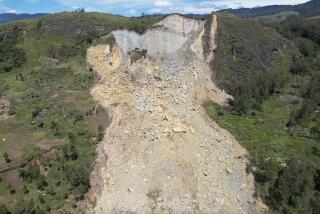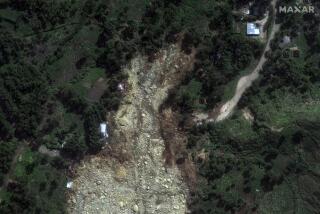Albright, in New Guinea, Bears a Gift
- Share via
PORT MORESBY, Papua New Guinea — Secretary of State Madeleine Albright stopped at this key Pacific nation Wednesday to offer new U.S. aid after a devastating tsunami and to signal interest in developing stronger relations with the region.
Albright announced that the United States will provide an additional $650,000 to deal with the aftermath of the July 17 disaster, particularly to improve the island’s seismic early warning system. Last week, the Clinton administration flew in three planeloads of food, medicine, tents, cots and other aid, worth about $400,000.
En route here, Albright’s plane flew low over the devastated northern coastline where the tsunami--three earthquake-generated waves, one of which reached three stories high--wiped away entire villages along a 20-mile stretch and dragged thousands of people into the water.
Death counts vary for the tsunami, with some putting the fatalities at more than 2,000 and growing. Bill Skate, the prime minister of Papua New Guinea, told reporters Wednesday that 1,654 people were known to have perished.
“I could only begin to imagine the horror of what happened,” Albright told reporters, adding that she opted not to visit the site to avoid getting in the way of relief efforts. “I didn’t want to create another tidal wave.”
Government officials said the biggest task after clearing the remote area and rehabilitating the injured will be resettling people in new homes and helping them start their lives over again.
Papua New Guinea was originally put on Albright’s itinerary to send a message of U.S. interest in the Pacific region’s political and economic development and in global issues such as the environment, a senior U.S. official said.
The California-size nation of 4.3 million people, which shares about half of the largest Pacific island--New Guinea--with Indonesia, reflects the gradual development of the region. Just a generation ago, Papua New Guinea was one of the last areas in the world with headhunters. Many lived a near-Stone Age existence.
The divisions were so deep among diverse tribes and clans that 715 languages competed with one another--the highest concentration of different tongues in the world, according to U.S. officials.
The island’s culture was evident when tribal dancers--with painted faces and arrayed in parrot feathers, grass skirts and dog-tooth necklaces--performed twice for Albright.
One group of dancers had ash-blackened faces and wore massive headdresses of human hair accumulated from their ancestors. Toney Kin, the lead dancer, said he was unsure just who Albright was but thought she might be the “secretary-general.”
Papua New Guinea, which gained independence in 1975, is now a fledgling democracy, with seven major parties and a parliament of 109 members, including two women.
Albright, who is the highest-ranking U.S. official to visit since the island nation’s independence, made the stop in part to signal that Washington believes conditions are ripe for greater American investment in Papua New Guinea, which is rich in gold, copper, hydrocarbons, timber and fisheries.
Despite setbacks from nature and poverty, Skate felt confident enough to invite President Clinton to visit Port Moresby, the capital, when he attends the Asia Pacific Economic Cooperation forum in New Zealand next year.
More to Read
Sign up for Essential California
The most important California stories and recommendations in your inbox every morning.
You may occasionally receive promotional content from the Los Angeles Times.













